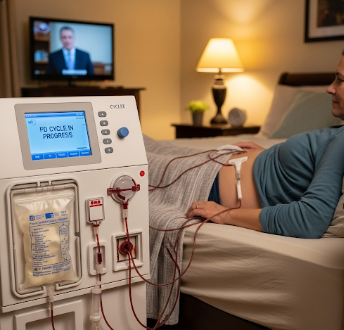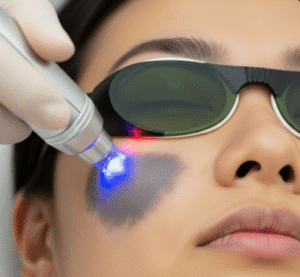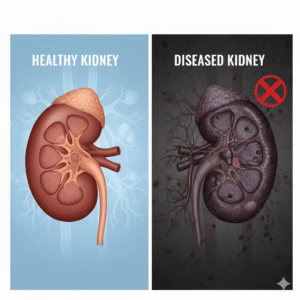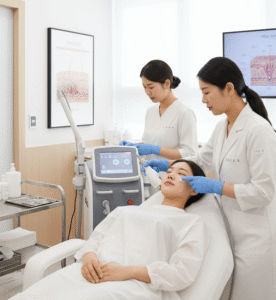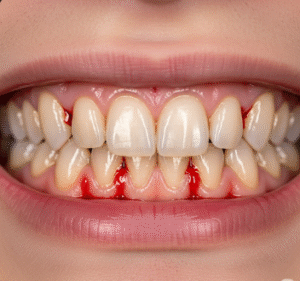Overview
Peritoneal dialysis (PD) is a renal replacement therapy used to remove waste products and excess fluid from the blood in patients with chronic kidney disease or kidney failure. Unlike hemodialysis, PD uses the peritoneal membrane in the abdomen as a natural filter.
South Korea is renowned for high-quality dialysis care, offering state-of-the-art peritoneal dialysis programs, expert nephrologists, and patient-centered home dialysis training, making it a leading choice for kidney failure management.
What is Peritoneal Dialysis?
Peritoneal dialysis involves filling the abdominal cavity with a dialysis solution via a catheter, allowing waste products and excess fluid to diffuse from blood vessels into the solution, which is then drained. Key types include:
✔ Continuous Ambulatory Peritoneal Dialysis (CAPD): Manual exchanges performed multiple times daily.
➔ Automated Peritoneal Dialysis (APD): Machine-assisted exchanges, typically overnight.
● Hybrid PD: Combines CAPD and APD for flexible schedules.
★ Peritoneal catheter placement: Surgical or laparoscopic insertion ensures safe and long-term access.
PD allows patients to manage dialysis at home, maintain flexibility, and reduce the need for frequent hospital visits.
What are the Benefits?
Peritoneal dialysis offers multiple advantages:
✔ Flexibility and independence: Dialysis can be done at home or work.
➔ Continuous fluid removal: Gentle, more physiologic process than intermittent hemodialysis.
● Better preservation of residual kidney function compared to hemodialysis.
★ Fewer dietary restrictions and more liberal fluid intake in some cases.
➤ Improved quality of life: Allows travel and daily activities with minimal interruption.
Procedure Details
1) How should I prepare for Peritoneal Dialysis?
Proper preparation ensures safety and effectiveness:
✔ Medical evaluation: Kidney function tests, imaging, and assessment of abdominal cavity.
➔ Catheter placement planning: Selection of appropriate site and surgical method.
● Infection prevention: Skin preparation, antibiotics if needed.
★ Patient education: Learn exchange techniques, hygiene, and complication monitoring.
➤ Lifestyle adjustments: Diet modification, fluid management, and safe storage of dialysis solution.
2) What happens during the procedure Peritoneal Dialysis?
The process includes catheter placement and fluid exchange:
✔ Catheter insertion: Surgical or laparoscopic placement in the abdomen.
➔ Initial healing: 1–2 weeks for catheter site to stabilize.
● Dialysis exchange: Dialysis solution introduced into abdominal cavity, dwells for a set time, then drained.
★ Cycle frequency: CAPD requires 3–5 exchanges per day; APD uses automated nighttime cycles.
➤ Monitoring: Watch for signs of infection, fluid balance, and catheter function.
Korean hospitals provide training for home PD, ensuring patients and caregivers are confident in managing dialysis independently.
3) What happens after Peritoneal Dialysis?
Post-procedure care focuses on catheter maintenance, infection prevention, and effective dialysis:
✔ Daily care: Sterile technique during exchanges.
➔ Site monitoring: Look for redness, swelling, or discharge at catheter site.
● Fluid balance monitoring: Track weight, intake, and output.
★ Follow-up: Regular visits with nephrologist for labs, catheter assessment, and PD adequacy.
➤ Lifestyle adaptation: Maintain hygiene, nutrition, and safe handling of dialysis supplies.
Risks / Benefits
Possible Risks:
✔ Peritonitis (infection in the abdominal cavity)
➔ Catheter malfunction or displacement
● Hernia or fluid leakage at catheter site
★ Abdominal discomfort, bloating, or nausea
➤ Rare complications: bowel injury or allergic reactions to dialysis solution
Major Benefits:
✔ Home-based dialysis offering flexibility
➔ Continuous gentle removal of wastes and fluids
● Preservation of residual kidney function
★ Reduced dietary restrictions and improved lifestyle
➤ Effective long-term management of chronic kidney disease
Recovery and Outlook
✔ Initial recovery: 1–2 weeks after catheter placement before starting regular PD.
➔ Adaptation period: Patient learns to perform exchanges safely and efficiently.
● Long-term outcome: Stable kidney function replacement, symptom relief, and improved quality of life.
★ Monitoring: Lifelong follow-up with nephrologist to prevent infection and ensure adequate dialysis.
➤ Lifestyle: Many patients continue work, travel, and daily activities while on PD.
When To Call the Doctor
Contact your doctor if you notice:
✔ Fever, chills, or abdominal pain
➔ Cloudy dialysis fluid or unusual drainage
● Redness, swelling, or discharge at catheter site
★ Nausea, vomiting, or sudden weight changes
➤ Catheter malfunction, blockage, or leakage
Best Korea Option / Process
South Korea provides world-class peritoneal dialysis care with:
✔ Leading hospitals: Samsung Medical Center, Asan Medical Center, Seoul National University Hospital.
➔ Advanced catheter placement and training programs for home dialysis.
● Expert nephrologists: Specialized in chronic kidney disease and PD management.
★ Comprehensive post-care: Infection monitoring, nutritional counseling, and ongoing dialysis optimization.
➤ Medical tourism support: Translation, travel coordination, and follow-up care for international patients.
✅ Highlights:
✔ Peritoneal dialysis provides home-based kidney function replacement
➔ Flexible, gentle, and continuous removal of waste and fluid
● Preserves residual kidney function and improves quality of life
★ Risks include infection, catheter malfunction, hernia, or abdominal discomfort
➤ Korean hospitals offer advanced PD training, catheter placement, and expert monitoring

